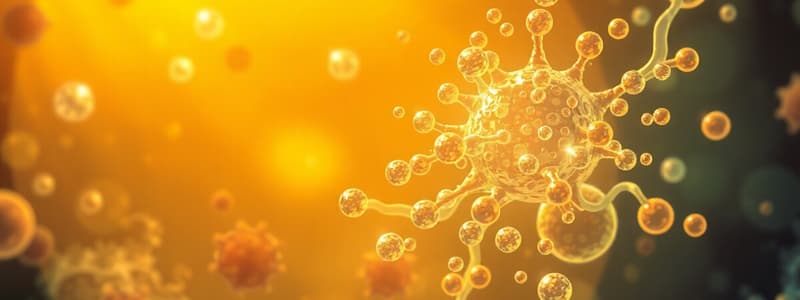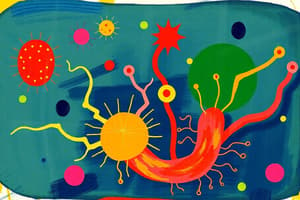Podcast
Questions and Answers
Which method involves growing microorganisms on a suitable medium?
Which method involves growing microorganisms on a suitable medium?
- Immunological
- Indirect methods
- Culturing (correct)
- Molecular biology
Selective media allows only certain types of bacteria to grow.
Selective media allows only certain types of bacteria to grow.
True (A)
What does differential media help to distinguish?
What does differential media help to distinguish?
- The temperature of incubation
- Certain characteristics of microorganisms (correct)
- The size of the petri dish
- The exact number of microorganisms
__________ is one method that allows for enumeration and biochemical testing of microorganisms.
__________ is one method that allows for enumeration and biochemical testing of microorganisms.
Molecular biology methods are slower than culturing methods.
Molecular biology methods are slower than culturing methods.
Match each media type with its description:
Match each media type with its description:
What is a key use of molecular biology methods in microbiology?
What is a key use of molecular biology methods in microbiology?
Immunological methods use antibodies to recognize molecular markers.
Immunological methods use antibodies to recognize molecular markers.
What is an antigen in the context of immunological methods?
What is an antigen in the context of immunological methods?
__________ recognize molecular markers on microorganisms.
__________ recognize molecular markers on microorganisms.
Culturing microorganisms involves growing them on a suitable media in a petri dish.
Culturing microorganisms involves growing them on a suitable media in a petri dish.
What is a petri dish used for in microbiology?
What is a petri dish used for in microbiology?
Different organisms have different __________ requirements.
Different organisms have different __________ requirements.
All microorganisms have the same growth requirements.
All microorganisms have the same growth requirements.
Which factor does NOT support the growth of different microorganisms?
Which factor does NOT support the growth of different microorganisms?
__________ media have a known chemical composition.
__________ media have a known chemical composition.
Complex media has an exact chemical composition.
Complex media has an exact chemical composition.
What type of experiments often use defined media?
What type of experiments often use defined media?
Defined media are more __________ to make compared to complex media.
Defined media are more __________ to make compared to complex media.
Complex media is easier to make than defined media.
Complex media is easier to make than defined media.
__________ media contains ingredients like casein digest and yeast extracts.
__________ media contains ingredients like casein digest and yeast extracts.
What is the purpose of selective media?
What is the purpose of selective media?
Only certain bacteria can grow on selective media.
Only certain bacteria can grow on selective media.
Match the descriptions to the terms
Match the descriptions to the terms
What can differential media help distinguish?
What can differential media help distinguish?
On MacConkey agar, what color do lactose-fermenting bacteria appear?
On MacConkey agar, what color do lactose-fermenting bacteria appear?
Each colony on a plate is assumed to be from a single bacterial or yeast cell.
Each colony on a plate is assumed to be from a single bacterial or yeast cell.
For enumeration of microorganisms, the organisms are plated at different __________.
For enumeration of microorganisms, the organisms are plated at different __________.
Which range is generally considered countable for colonies on a plate?
Which range is generally considered countable for colonies on a plate?
If a plate has >300 colonies, it is too numerous to count.
If a plate has >300 colonies, it is too numerous to count.
Results of enumeration are reported in __________.
Results of enumeration are reported in __________.
What can molecular biology methods be used to detect?
What can molecular biology methods be used to detect?
__________ chain reaction is a molecular biology method used to detect specific organisms.
__________ chain reaction is a molecular biology method used to detect specific organisms.
An __________ is a molecular marker on a microorganism that is unique to it.
An __________ is a molecular marker on a microorganism that is unique to it.
Match the term with what it recognizes.
Match the term with what it recognizes.
What is ELISA used for?
What is ELISA used for?
__________ acidity in milk is a more time-efficient measure of a characteristic related to microbial activity.
__________ acidity in milk is a more time-efficient measure of a characteristic related to microbial activity.
Titratable acidity in milk is a direct method of microorganism detection.
Titratable acidity in milk is a direct method of microorganism detection.
An indirect method is considered what?
An indirect method is considered what?
Flashcards
Microorganism Detection
Microorganism Detection
Methods to find, name, and count microbes in food samples.
Culturing Microorganisms
Culturing Microorganisms
Growing microorganisms in a controlled environment.
Selective Media
Selective Media
Allows only certain microbes to grow.
Differential Media
Differential Media
Signup and view all the flashcards
Defined Media
Defined Media
Signup and view all the flashcards
Complex Media
Complex Media
Signup and view all the flashcards
Selective Media Function
Selective Media Function
Signup and view all the flashcards
Differential Media Function
Differential Media Function
Signup and view all the flashcards
Colony Assumption
Colony Assumption
Signup and view all the flashcards
Polymerase Chain Reaction
Polymerase Chain Reaction
Signup and view all the flashcards
Antigen
Antigen
Signup and view all the flashcards
Antibody
Antibody
Signup and view all the flashcards
Indirect Methods
Indirect Methods
Signup and view all the flashcards
Study Notes
- Methods exist for detecting, identifying, and counting microorganisms in food
Culturing
- Growing microorganisms on suitable media in a petri dish
- Different organisms require different growth condition
- Different types of media, growth temperatures, and atmospheres facilitate microorganism growth
- Culturing allows for enumeration and biochemical testing
Selective vs Differential
- Selective media: Only certain bacteria can grow
- Differential media: Many bacteria can grow, can distinguish characteristics; blood agar is an example for bacteria that break down red blood cells
- Media can be both selective and differential
- MacConkey agar: Only gram-negative bacteria grow (selective); bacteria that can ferment lactose appear pink (differential)
Defined Media
- Exact chemical composition of the media is known
- Useful for metabolic experiments
- More labor intensive to make
Complex Media
- Exact chemical composition is unknown
- Contains ingredients like casein digest, soybean digest, and yeast extracts
- Easier to make
Enumeration of microorganisms
- Grow organisms in a suitable medium at different dilutions
- Count colonies after a growth period of 1-3 days with 1 mL of media plated
- Each colony on a plate is assumed to be a single bacterial or yeast cell in the original liquid
- Countable range is 30-300 colonies
- Can report estimated plate counts if <30, >300 is too numerous to count
- Results are reported in CFU (colony forming units)/mL in the original sample
Molecular biological methods
- Polymerase chain reaction detects DNA or RNA of specific organisms
- Useful for identification or quantification
- Faster than culturing methods
Immunological methods
- Antigen: A unique molecular marker is present on the microorganism
- Antibody: Recognizes the molecular marker (antigen)
- Lateral flow assays used for qualitative testing
- ELISA used for quantitative testing
Other detection methods
- Indirect Methods: A more time-efficient measure of a characteristic related to microbial activity
- Eg: titratable acidity in milk
Studying That Suits You
Use AI to generate personalized quizzes and flashcards to suit your learning preferences.




